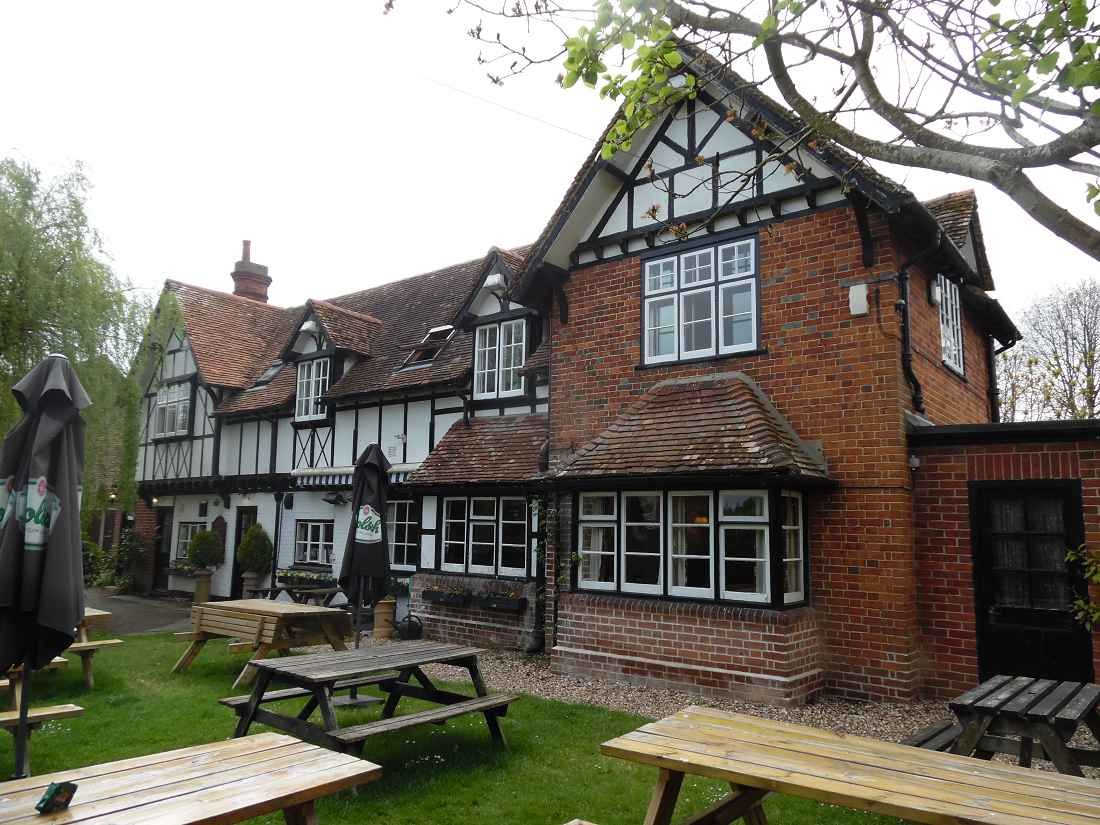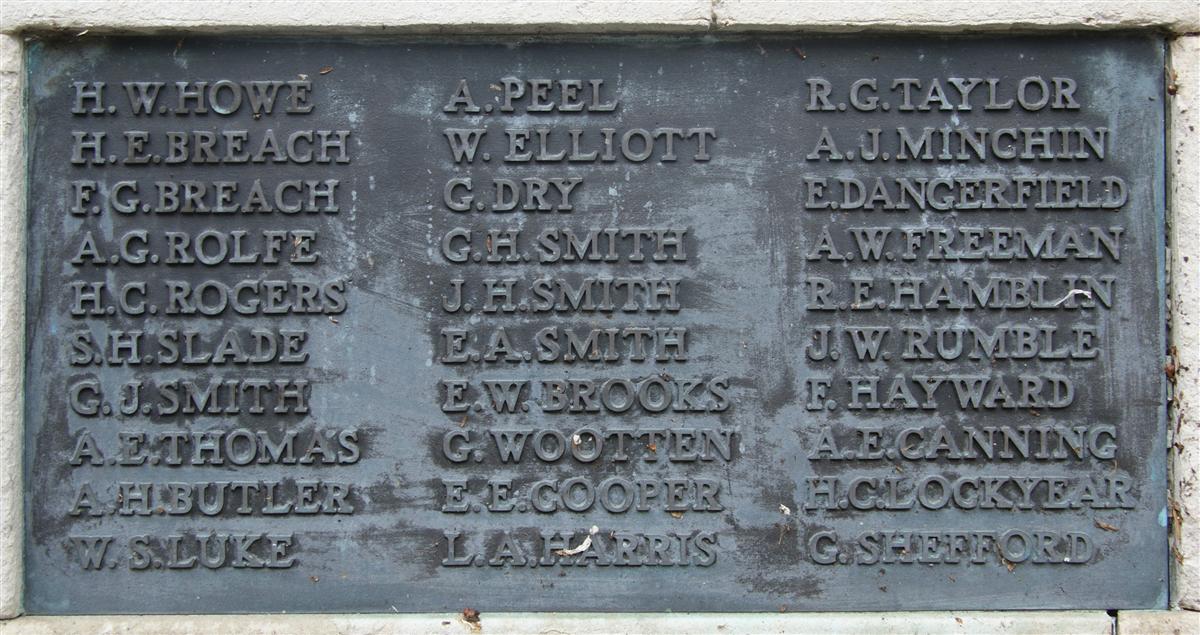George James Smith
Private George James Smith, 11th Battalion, The Queen's (Royal West Surrey Regiment).
George was born in Winterbourne, near Newbury, in 1899 the son of James Smith, a journeyman baker, and his wife Rose (née George). He had a twin sister, Lilian Grace, and two other sisters: Agnes Elaine, born 1896, and Ida Mary, born 1904. Between his birth and that of his younger sister the family moved from Winterbourne to Newbury.

The New Inn, Winterbourne, during its time as the Winterbourne Arms. The pub was a victim of changing times and has now been converted to a private house. |
Prior to 1907 this shop was listed in directories as a baker’s shop run by Thomas Bartholomew. Bartholomew was not old (early 40s) but it seems that he was ready to retire, probably owing to health problems (he would die in 1912 aged only 50). He may have offered James a chance to come into the business, perhaps initially as an employee or junior partner before handing over the running of the shop in 1906 (directories were compiled at the end of the year preceding publication).
When he retired Bartholomew's son, Arthur, was only 8-years-old, far too young to take on the business - he became another casualty of the war when he died in November 1918.
However James came to take on the business it was a success, Smith’s Bakery was still operating on the premises in the 1960s, the name surviving the loss of James’ only son. In the 1960s the bakery moved a couple of doors down towards the Broadway and was still there in the 1970s.

The regimental badge of the Queen's Royal West Surrey Reriment, as used on CWGC headstones. |
In 1917 the Prime Minister, David Lloyd George, dissatisfied with the Army’s running of the war in France, had determined to limit its manpower to prevent a repeat of the Passchendaele campaign of 1917. This bizarre situation forced Field Marshall Douglas Haig, commanding the five British armies on the Western Front to reorganise the structure of the British brigades, reducing them from four infantry battalions to three – the men from the fourth being used to bring the others up to strength.
This reduction in strength was not matched by a commensurate reduction in the length of Front manned by the British. This meant that Haig was forced to deploy his depleted armies on a defensive basis – exactly as Lloyd George intended. No doubt he was pleased with the effect of his ploy – until 21 March 1918 when the Germans, massively reinforced by troops released from the Eastern Front following the collapse of Russia, burst through the British positions on the Somme section of the Front. Two further attacks on the British on the Lys and the French and British along the Chemin des Dames exposed allied weaknesses; there were Germans closing in on Paris – all of a sudden men began to pour out of their training barracks and across the channel – the Government even reduced the age limit from 19 to 18½. 500,000 men reinforced Haig’s forces – George was almost certainly one of them. On 8 August, a few months after the shock of the German Spring Offensives the massively reinforced British struck back – Lloyd George’s fear of another British offensive was realised. However, this was not another Passchendaele, the British were well trained, well equipped and well supplied – the Germans were shattered by their springtime efforts, short of every form of supplies (from munitions to food) and their morale was crumbling. At the Battle of Amiens the tide turned for the last time, and, for the next 100 days the story was of constant British advance, back across the territory lost in March, through the much vaunted Hindenburg Line and on towards the Belgian border. On 11 November an armistice brought the fighting to an end after the Germans agreed to an unconditional surrender.
Sadly the armistice was too late for George, he was killed in action on 1 October.
War Diary, 11th Battalion, Queen’s (Royal West Surrey) Regiment – 1 October 1918
YPRES Orders received at 1sm for Bde to move by March route at 7am to YPRES-MENIN RD via TENBRIELEN and AMERICA. The Battalion moved t 6.36am. On reaching TENBRIELEN the Bde halted owing to advanced Guards of 122nd Bde being checked at AMERICA. At 4.25pm orders were received for the Battalion to attack with 23rd Middlesex on the right and make good the railway WERVICQ-MENIN. The Battalion assembled on the line at 5.15pm and advanced at 5.45pm (C & D in front B & A in support). After advancing about 1500 yds it came under very heavy Machine Gun fire from tall chicory field in Q and owing to casualties and darkness it was not possible to go farther, and the Battalion halted and dug in on the line. Casualties – Killed: Capt Baker, 2/Lieut Strawson. Wounded: Lieut Edwards, 2/Lieuts Denton & May. During the march to the place of assembly the Battalion came under very heavy shell fire and seven casualties were caused. Major Holden DSO, MC was seriously wounded & Lieut Cooks MC TMB was killed.
Following the outstanding success at Amiens in early August the 2nd and 5th Armies in Flanders began their advance on 16 August. By early September they had recaptured the territory lost to the Germans in the spring. It took three weeks to move their artillery forward and re-establish good supply routes etc. On 28 September they attacked the old German lines south of Ypres – these were a far tougher prospect that the hastily constructed defences they had faced in August. Steady progress was made, the lines gave way bit by bit; by 1 October the 11th Queen’s were at Tenbrielen about six miles into the German defences – almost through. As the battalion diary relates the Germans were not giving up without a fight – George died that day, probably killed by shellfire since his body was not recovered at the time.
After the war there was a huge battlefield clearance exercise, which uncovered many unburied corpses. George was found at map reference P.18.b.9.3 (sheet 28), to the south of the hamlet of America which lay on a line of German trenches that may well have been the last of their long established defence lines.
 George's name on Newbury War Memorial. (lower left) |
Locally he is remembered on Tablet 10 of the Newbury Town War Memorial and on the Speenhamland Shrine , the parish memorial for St Mary’s, Speenhamland, which was moved to St Nicolas’ Church when St Mary’s was demolished. He was also remembered on the school memorial (now lost) in St Mary’s School, Speenhamland.

